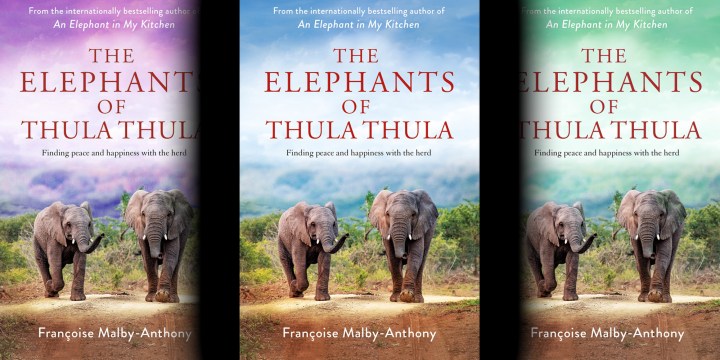BOOK EXTRACT
The Elephants of Thula Thula — a risky rhino rescue

Françoise Malby-Anthony is the owner of a game reserve in South Africa with a remarkable family of elephants whose adventures have touched hearts around the world. In ‘The Elephants of Thula Thula’, joys and challenges of a life dedicated to conservation are vividly described. In this extract, Malby-Anthony tells of a rhino rescue in the Zululand bush.
The clatter of helicopter blades split the peace of the Zululand bush. The chopper swooped down, coming in low, herding our two rhinos, Thabo and Ntombi, towards the open savannah grassland. I watched from the top of a nearby hill, nervous and on edge. Tranquillising and dehorning our rhinos is a major undertaking and potentially risky — for the animal, and for the humans involved. But it has to be done to protect our rhinos against heavily armed and ruthless poachers who would kill them to get their horns.
The rhinos tried to outrun this great bird, but to no avail. As it drew close, the vet, Trever Viljoen, leaned out of the open side of the chopper with a rifle. I caught a glimpse of his slim frame, and his face, intently focused on his mark. He took aim and fired.
He fired a second time.
I didn’t see the tranquilliser darts hit their target, but within minutes I could see the effects of the M99, a drug 1,000 times stronger than morphine. The two rhinos staggered and swayed. The vet’s team and our rangers and volunteers ran towards them to control their fall and prevent them from injuring themselves. The rhino must come to rest on its chest and not on its side, so that it can breathe properly, and so that the vet can reach the horn to remove it. The assistant vet tied a cloth over each animal’s eyes, and plugged their ears.
With shaking hands, an ashen-faced young volunteer placed a tarpaulin under Ntombi’s huge head, and another did the same for Thabo. The horns are so valuable — they fetch $90,000 a kilo on the black market in the Far East — that even the tiniest shavings of horn must be gathered up, not a sliver left to attract poachers. Larry Erasmus, our security consultant, had assembled a team of ten armed men, trained anti-poaching dogs and several specially reinforced security vehicles to keep watch over the whole operation, to deter poachers and keep us and the rhinos safe.
Trever got straight to work with a chainsaw, first on Thabo, then on Ntombi, cutting away at the horn with intense focus. As ever, I was calmed by his presence in these stressful situations. He is always meticulously prepared and gives our animals excellent attention, whilst answering my questions with patience and humour.
Although it’s painless for the rhino, a dehorning is a brutal, noisy thing to watch. Morgan Dias Simao, a filmmaker from France, was positioned right behind our vet, his cameras trained on the sleeping giants and the swarm of attendants. This was Morgan’s first experience of dehorning. I could see the tears in his eyes behind his sunglasses. I knew how he felt — the first time I saw the vet start up a chainsaw and go to work on Thabo’s horn, I cried as I witnessed what we had to do to keep our precious rhinos safe. I had now grown somewhat used to it, as we dehorn the Thula Thula rhinos every fourteen months. A rhino horn is simply keratin, the same substance that makes up our hair and our fingernails. Just like our fingernails, it continues to grow, and poachers would think nothing of killing a magnificent animal for just an inch or two of regrowth.
The dehorning itself is surprisingly quick. Within minutes, the horns were removed. Each one was immediately weighed and the rhino’s name and the position of the horn is written on the base in permanent marker — ‘Ntombi Front’ and ‘Ntombi Back’. A little hole is drilled into the horn, a microchip is inserted and it is sealed with wood glue. The vet signs it off, and the horn and the vet’s paperwork are stored in a secure vault, not on our premises. The microchip is registered with the wildlife authorities, who keep a record of all the horns, and issue us with a certificate. The microchipping programme allows them to keep track of legal horns, to link each removed horn to a specific rhino and to trace stolen horns.
A DNA sample from the horn forms part of the state’s rhino DNA database. When poachers are found in possession of a horn, matching its DNA to a specific rhino on a specific farm can help police to build a strong case and get a conviction.
Visit Daily Maverick’s home page for more news, analysis and investigations
Getting the horns off the premises under armed guard was like a military operation. The guards were fast and efficient, their eyes scanning the bush and the sky as they bundled the horns into the vehicles for transportation to a secure location.
We were very aware that dangerous people would stop at nothing — including murder — to get their hands on this valuable cargo. A rhino horn is entirely useless to anyone other than a rhino, who uses it to dig, forage, break branches, and for defence. And yet many people, particularly in the East, believe that the powdered horn will bring health, strength and happiness, and will pay a fortune to get their hands on it. Around 10,000 rhinos have died in the past decade to meet this demand.
While the security team dealt with the removed horns, the freshly cut stumps were sterilised against infection and oiled to prevent cracking. Trever injected the reversal drugs to counter the anaesthetic, and everyone moved safely away from the stirring rhinos. It was a relief to see Ntombi get up quite quickly and start moving away from the dehorning site. Thabo looked cross-eyed and disorientated, as if he were waking up with a bad hangover after a big night out. He walked slowly off into the bush beyond the vehicles.
The strong anaesthetic leaves the rhinos weak and confused for a while, so the rangers always monitor them closely for forty-eight hours afterwards, in case they get into trouble. When ranger Victor and the volunteers went to check on them some time later, Thabo came right up to the car. There was no sign of Ntombi which was strange, because the two were always together. Thabo leaned groggily against the vehicle so that it couldn’t move. Victor told me afterwards that it felt as if Thabo had come to tell them something, that he didn’t want them to leave.
When they found Ntombi, they realised why Thabo had been trying to keep them there. She needed their help. Still woozy, she had staggered into a drainage ditch that channelled the water run-off from the plain. She followed the drainage line, the thick mud pulling at her feet. The ditch narrowed to a point where Ntombi could go no further. Nor could she reverse. She was stuck. The sun was low on the horizon and evening was fast approaching. Ntombi was tired from the anaesthetic and from struggling against the mud. She didn’t have the strength to help herself.
The rangers gathered around anxiously.
“What are we going to do? There’s no way forward and it is too narrow for her to turn around.”
“Well we can’t pull her out.”
“We can’t leave her here. If it rains and the ditch fills up, she could drown.”
“If we make the channel wider ahead of her, and create a kind of ramp, she can get out. We need to dig,” said Vusi. “Where’s the TLB?”
He was referring to the tractor-loader-backhoe, which is used for digging and clearing jobs.
Muzi answered, “It’s at the other side of the reserve, it was being used at the quarry. It will take half an hour to get here.”
“Tell them to come, but we can’t wait. She might injure herself. We need to start digging, to clear the way for the TLB when it comes,” said Vusi. “And get hold of Siya. Tell him what’s happened and get everyone out to help. And call the APU. We need all the manpower we can get.”
The volunteers ran to the vehicles for spades and picks and whatever else they could find. Luckily, Ntombi didn’t panic. She was very placid, standing quite still and breathing heavily. She knew that she was in trouble, and that we were helping her.
“Where’s Thabo?’ Khaya asked Richard the rhino monitor, voicing the question that was on everyone’s mind. This could turn into a very dangerous situation. If he saw his companion in distress, and a dozen humans gathered round, his instinct would be to protect her.
“He went the other way, past the vehicles. I don’t see him. I’m watching for him though,” said Richard.
“Good. Keep a lookout. We’re going to get to work.”
The Anti-Poaching Unit (APU) arrived with their guns in case of trouble.
Morgan stationed himself behind the group to take pictures. The digging was hot, sweaty work and one of the APU guys handed Morgan his rifle, saying, “Please hold this while I take my jacket off.”
Morgan took it gingerly. He had never touched a gun in his life. As he stood there with the rifle, pondering what a strange position he had found himself in, deep in the African bush, holding a gun while men dug a rhinoceros from the mud, he heard a noise. He turned to look. Thabo was ten metres from him and coming fast.
“Rhino charging!” Morgan shouted.
It was pandemonium!
Every book, every ranger will tell you not to run from a wild animal unless it’s absolutely your only choice. This seemed like that moment. DM/OBP
You’re invited! On Wednesday 14 September at 12pm, join Dr Don Pinnock with author and owner of Thula Thula Françoise Malby-Anthony for the virtual book launch of Elephants of Thula Thula. It’s a free virtual event, which will examine the story behind the story. If you’d like to join, register here.



















 Become an Insider
Become an Insider
Comments - Please login in order to comment.